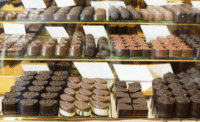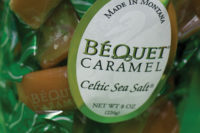Since Bryan Graham founded Fruition Chocolate Works and Confectionery in Shokan, N.Y., six years ago, he’s seen an “explosion” in the craft chocolate field.
Graham estimated there were 15-20 companies across the United States making their own small-batch chocolate in 2011. Now he posits that total has surpassed 200.
“We’re seeing amazing growth in that regard,” Graham said. “I think a lot of that is tied to people wanting to know where their food comes from, that it’s sourced ethically and there’s a craftsman behind the food that they’re eating.”
And, people really like chocolate, whether it’s premium, ultra-premium or among the mass market classics. In the 11th edition of “Chocolate Market in the U.S.,” Packaged Facts, a division of MarketResearch.com, projected the U.S. chocolate market to hit $22.5 billion in 2017, up from the $21.81 billion estimated in 2016.
Everyday chocolate makes up just over 80 percent of the total chocolate market, but its dollar sales stayed virtually flat (0.3 percent) during the 52 weeks ending April 17, 2016, according to data presented in the report from IRI, a Chicago-based research firm. Premium chocolate, however, experienced more growth.
But first, it’s necessary to define premium chocolate. The widest tier — the “everyday gourmet” and “affordable luxury” category — includes products priced between $8 and $15.99 per lb., according to Packaged Facts. These items carry a price premium over more mainstream chocolate products and serve as a gateway for consumers looking to move up the ladder.
Products that are “upscale premium” fall between $16 and $23.99 per lb. The last tier — “super premium” — has developed from continued sophistication of consumer preferences. These products are priced at or above $24 per lb.
And the higher the price, the more the growth the category has seen. The “everyday gourmet” tier pulled in $1.63 billion over the year ending April 17, 2016, up 3.6 percent from the year before, IRI reported.
Meanwhile, the upscale premium category generated $255 million, up 9 percent from the year before. The ultra-premium category pulled in just $55 million, but it was the only chocolate market subset to see double-digit growth — 15.4 percent.
That’s not surprising to Todd Masonis, co-founder and ceo of San Francisco-based Dandelion Chocolate. He said once customers learn the stories behind the cocoa — and the effort and care taken to get it from bean to bar — they’re more inclined to pay $8 to $10 for few ounces of it.
“It’s not a faceless commodity” he said. “It is something they can get very excited about.”
Anette Righi DeFendi, head chocolatier for Wisconsin-based KOHLER Original Recipe Chocolates, agreed.
“Premium chocolate is meant to be an experience — something you taste, think about and talk about,” she said. “Much like wine, it’s meant to be savored and enjoyed.”
Cocoa sourcing
Chocolate makers at all levels are putting particular emphasis on sourcing — both on the countries and regions they represent and on the practices they use.
Dandelion Chocolate uses cacao from farms throughout Central and South America, sorting each shipment of beans by hand. The chocolate company also tries several different roasts before achieving a desired flavor profile — all to accentuate the complexities and subtleties of each type of cacao.
Most recently, Dandelion introduced the Hacienda Azul, Costa Rica 70% bar, which features cacao from hybridized clone trees on the Hacienda Azul estate in Turrialba, Costa Rica. The bar, with a strong chocolatey base, has notes of caramel, toffee and graham cracker.
And, to make sure customers know exactly where Dandelion’s cocoa is coming from — and how much the chocolate maker paid for it — Dandelion releases an annual Sourcing Report, opening up the whole process. The company has opted to issue the reports instead of pursue sustainability certifications.
“As a company, we’re very concerned with doing the right thing and less concerned with having a rubber stamp from a large organization,” Masonis said. “Rather than try to rely on third-party certification, we just try to make everything completely transparent.”
Graham, meanwhile, said Fruition Chocolate works with Uncommon Cacao, an organization that helps cacao farmers sell high-quality beans to chocolate makers and supports farming communities.
However, Fruition does have a direct relationship with farmers producing Pure Nacional beans in Marañón Canyon, Peru, allowing for the creation of Marañón Canyon Dark and Marañón Canyon Dark Milk bars. Both have earned a variety of awards.
Fruition’s Corazón Puffed Quinoa bar also features Marañón and Piura Blanco cacao. The milk chocolate bar also highlights Peruvian inclusions, such as cocoa nibs aged in pisco, flor de sal, puffed quinoa, maracuya (passion fruit) and lime. Net proceeds go toward Corazón de Dahlia, a nonprofit founded by Graham’s wife, Dahlia, that supports impoverished children and communities in Peru.
Flavor trends
Honoring distinct flavors in cacao has become a standard practice for some chocolate makers, but there are consumers who seek creations incorporating more than cacao and sugar.
“This is an extremely exciting time in the premium chocolate market, as the opportunities and flavor combinations are endless and constantly evolving,” DeFendi said. “I’m always excited to see what other brands are doing and where the trends are heading.”
Packaged Facts pinpointed several trends for flavors and inclusions that have developed in the confectionery space. Incorporating fruits, such as blueberry, blackberry and acai, and nuts and seeds, such as quinoa and pumpkin, continues to remain popular.
Some confectioners have layered spicy flavors in with sweet and fruity ones, while others have launched creations playing off of other desserts or nostalgic treats such as caramels, brittles and turtles.
In line with that trend, KOHLER recently introduced Butterscotch Hop to its gourmet chocolate line. These pieces feature a butterscotch center and shimmery gold airbrushed on the exterior.
“This delight brought diversity to our chocolate line in its distinct asymmetrical design and smooth, creamy and nostalgically butterscotch flavor profile,” DeFendi said.
To mark Fruition’s six-year anniversary, the company last month introduced a trio of bars inspired by favorite treats such as Carrot Cake, French Toast and Girl Scouts Thin Mints.
The Carrot Cake bar features white chocolate made with cream cheese powder, freeze dried carrot, dehydrated carrot cake and walnuts, while the French Toast bar incorporates pecans, bits of toasted brioche and maple sugar in a high-percentage cacao milk chocolate. Made with dark chocolate, the mint cookie bar has bits of chocolate sablé cookie and mint essential oil.
And as chocolatiers continue to experiment with flavors and ingredients, consumers should experiment right along with them, DeFendi said.
“I’d like more people to have an opportunity to taste and explore what premium chocolates really are,” she said. “There are some amazing chocolatiers in the country right now, and I’d love for consumers to take a chance to try something new.”










